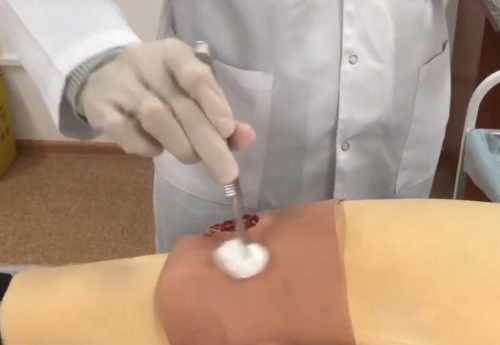There are many classifications of body surface injuries, such as accidental or surgical (surgical), intentional, and occupational.
Depending on cleanliness, wounds are divided into clean, contaminated and infected.
Here it should be clarified that in domestic conditions a wound is always considered contaminated because it was not inflicted with a sterile scalpel.
Wounds are differentiated by the mechanism of origin: stabbed, chopped, lacerated, bruised, cut, bitten, gunshot.
What Symptoms Are Associated with Open Wounds
The appearance of trauma is accompanied by the following symptoms:
- Bleeding. Depends on the size of the injury and localization. The head bleeds more because of the large number of blood vessels there.
- Pain. It appears with any injury and the degree of its intensity depends on the pain threshold and the location of the injury.
- Wound gaping. Divergence of the edge is connected with elasticity of the skin.
- Reddening, swelling, impaired organ function. Classic signs of inflammation appear with any tissue and skin injury.
Stages of Healing
At the moment of injury, the first stage of the wound process begins – inflammatory. It lasts about three days. Local changes appear – redness, swelling, pain. During this phase the traumatized area is cleared by special cells – macrophages and leukocytes.
After the first stage comes the next – the stage of growth and multiplication of cells, as well as tissue regeneration. They proceed simultaneously. A matrix of fibrin and collagen is formed, and a scar is formed. Scar formation is a necessary outcome of any wound.
How to Disinfect a Wound Fast?
For a small domestic wound caused by a knife, you need to remove contamination, rinse the wound, and treat it with an antiseptic (3% hydrogen peroxide solution, chlorhexidine aqueous). If there is no antiseptic, vodka, concentrated salt solution, chamomile infusion will do. Over the wound, put a sterile plaster or sterile bandage.
The bandage should be changed every day.
When Do I Need to See a Doctor?
If the injury is deep, and the length is 0.4-0.6 inches (1-1,5 cm) or more, you need to go to a trauma center or see a surgeon. The problem is that a wound longer than 1 cm takes longer to heal, so the doctor’s actions during stitching are aimed at restoring the integrity of the skin and the speedy repair of tissues. If redness, pus, and swelling appear, you should also consult a doctor.
During examination, the doctor evaluates the degree of contamination, makes the primary treatment, thereby clearing it of necrotic and non-viable areas, as well as stopping bleeding. Important: If more than 24 hours have passed since the injury, it is not sewn up because it is considered infected, so you should hurry up and see a doctor.
If the wound belongs to the category of lacerations, heavily contaminated with earth, bruised, gunshot wounds, a specialist will carry out primary treatment of the wound, and then appoint a vaccination against tetanus. You can refuse the vaccine if it has been less than 5 years since it was given, or for personal reasons, but remember that in this case you take full responsibility for your choice.
As a preventive measure for contaminated or infected wounds, your doctor may prescribe antimicrobials in the form of broad spectrum tablets, if necessary. Most often these are penicillin-type medications (Amoxiclav).
What Remedies Can Be Used for Wound Healing?
Among modern remedies there is a wide range of preparations with antimicrobial action, such as Levomekol, ready-made dressings Voskopran with ointment, Miramistin.
For faster healing of the scar, you can consider products such as Contraktubex (an all-vegetal product made from onion extracts), Clearvin, Dermatix.
How to Reduce the Scar or Even Get Rid of It?
Currently, there are a large number of options for treating scars. To begin with, it must be said that scars come in three varieties:
- Atrophic (retracted into the skin, it sort of fails in relation to the level of the skin),
- keloid (fresh scar is brightly colored purple, aged already looks pale pink, it rises in relation to the level of the skin and protrudes beyond the level of the wound)
- hypertrophic scar (protruding above skin level, pale pink to burgundy in color, it is formed by an excess of collagen)
Options for scar treatment should be determined with a specialist. Depending on the scar, both cosmetic and surgical methods can be used to treat it.
Cosmetic methods include meso injections and steroid injections. Effects on collagen in order to break it down or form it. There are a number of contraindications.
Surgical methods:
- Laser treatment. Also, depending on the type of scar and the laser device, different types of scars can be treated.
- Dermabrasion is a method of mechanical action by grinding tissue, removing a small layer of epidermis.
What Should I Keep in My Medicine Cabinet at Home?
Every person’s first aid kit for treating wounds should include:
- Sterile gauze and absorbent cotton
- Hydrogen peroxide 3%
- Iodine
- antiseptics.
About the Author
Reyus Mammadli is the author of this health blog since 2008. With a background in medical and biotechnical devices, he has over 15 years of experience working with medical literature and expert guidelines from WHO, CDC, Mayo Clinic, and others. His goal is to present clear, accurate health information for everyday readers — not as a substitute for medical advice.







